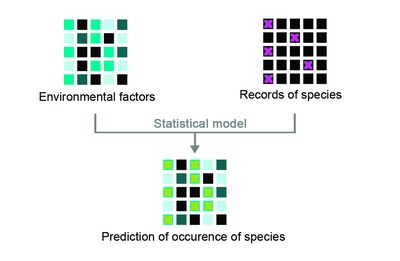Background
Landscape planning and conservation
|
|
The conservation of the health of nature has a high social relevance. Within planning processes specific laws regulate the protection of habitats, plant and animal species law, e.g. for the designation of construction projects. The assessment of protected species in such an area designated for planning is often highly demanding in terms of time and money. Research ideas: Species distributions depending on environmental conditions can be analyzed using both geographical information systems and computer-based statistical models. Data used for such analyses include spatially explicit plant and animal records and abiotic information at the local scale, e.g. management or soil type. Based on this local information, the probability of species occurrence related to environmental conditions can be extrapolated to a larger area, e.g. for a region.
Figure: Simplified drawing of the models used. Squares represent landscape pixels. Knowledge on environmental factors (shades of blue) and on species records (pink crosses) in the landscapes are combined in statistic models. Result is the prediction on the species' occurence in a landscape (green crosses) based on environmental conditions. |
|---|
Evaluation of the concerns of nature
|
|
The trade-off between issues of nature conservation and landscape planning is mainly focused on endangered species and specially protected habitats, e.g. Natura 2000 sites. Planning processes often not account for animals, plants and habitats that provide services to humans and thereby contribute to human well-being (e.g. by pollination, groundwater recharge or recreation), although the consideration of these services provided by nature for free are internationally demanded. Research ideas: In ecological research, the services that are provided by nature and that contribute to human well-being are termed “ecosystem services”. The underlying relationships between plants, animals and their environment are often complex and not suitable for applied planning processes. However, ecological knowledge of species interactions may help to identify simple indicators of individual ecosystem services in order to highlight nature’s intrinsic and economic value (e.g. wood production per hectare, tourism income per year). |
|---|


